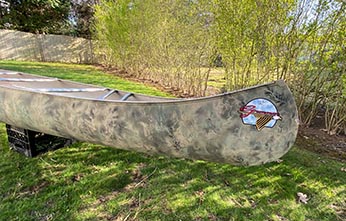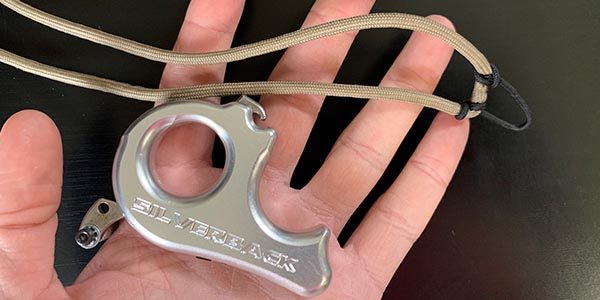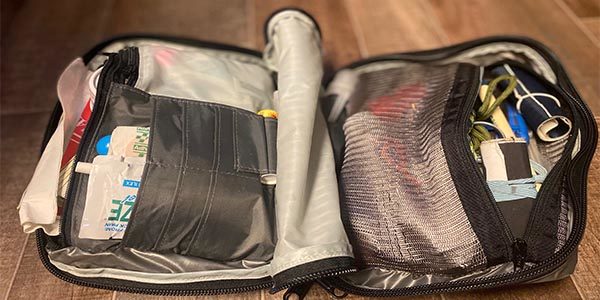
For most of us, it’s been a week or more in quarantine and we’re feeling worn down. Even though our new daily routines are becoming more normal by the hour, things still seem a little off. A distraction would be nice.
Now is the perfect time to let those New Year’s resolutions kick in and say no to procrastination. Binge-watching your way through the entire seven-hour documentary “Tiger King” might seem productive, but we’ve got a few suggested tasks that are more beneficial.
So, let’s get prepared for a return to normalcy. Here is a fool-proof two-week plan that’ll make sure you get stuff done and your couch doesn’t end up with a permanent imprint of your ass.
Learn to Owl Hoot
You already have enough calls to carry around the turkey woods, so ditch this locator call and use this time to annoy your family learning to use the hooter you were born with. Anybody can, it just takes a willingness to sound foolish while you practice. The key is to bring the air up from your diaphragm in kind huffing hoots, while using your tongue to compress the sound in the back of your throat. Cup your hands in front of your lips to create an air chamber to amplify the sound. The cadence, of course, is that classic “Who-cooks-for-you? Who cooks-for-you-allll” phrasing of a barred owl.
The truth is, your call often doesn’t have to sound that realistic to get a tom to gobble. It took me about a week to get to where I was adding trills and rolls to the end of sequence. It’s useful beyond turkey season. I can now almost always get owls to talk back to me when sitting around a campfire, winning bets and impressing the kids. –Anthony Licata
Custom Camo a Canoe
What’s more useful and cooler than a canoe that you’ve spray painted with your own one-of-a-kind camo? Very few things. Grab three cans of spray paint in green, brown, and black. Next, cut some vegetation: a fistful of long marsh grass, juniper or pine branches, and some hardwood branches with leaves. I normally hold the vegetation against the canoe as a stencil and lightly spray paint over it. Use different angles and colors, working slowly to see how the layers build together into a pattern. It’s done when you like it. –Anthony Licata
Can Venison
Think about meat storage just like a financial portfolio: It’s all about diversification. Canned meat is just another option in that effort, and it’s a perfect quarantine chore. Canned meat can be lightly seasoned and used as a base for a wide variety of staple meals—think casseroles, stews, tacos, and chilis.
The canning guide that should always be referenced is provided by the USDA National Center For Home Preservation. If you adhere to the USDA guidelines, you’ll be able to safely produce canned meat meals at home. Always remember these three things: cleanliness, headspace, and 50/50.
Clean your jars, lids, seals, and workspace. You will be canning at high heat that will kill just about anything, but why risk introducing something into your future meal that shouldn’t be there? In terms of headspace, the USDA recommends a one-inch space from the lid to the liquid.
The third rule is pretty simple to remember. If you are just starting out, stay with a mix of 50% liquid and 50% solid. Some meals may be a bit soupier than you’d like, but all you need to do is plan for extra simmer time or a nice filling bed of mashed potatoes. –Ryan Callaghan
Pickle Some Tongues
Tongue tacos are a delicious option, but don’t stop there. If you have never tried a pickled tongues, use this easy process to add some zip to your game.
Boiling tongues works well, but a pressure cooker is a much faster method. It’s the difference of several hours in boiling water versus 20 minutes at 15 psi. This sounds gross, but if you use a pressure cooker you get the added bonus of not needing to thoroughly wash the tongue. After the high-pressure cook, let the tongues rest in the refrigerator and get to work on your brine.
There are an endless amount of pickling brines, but Steve’s brine out of the MeatEater Cookbook is the best, tastiest option. You can add or subtract red peppers and garlic according to your taste.
Now it’s time to take the shirt off your tongue, as in, get rid of the taste buds. You can just slice your tongue into ¼-inch pieces with the skin on, but some folks will find the texture off putting. So, if you cooked it right, the skin should bubble up around the meat of the tongue much like a blistered hot pepper. You can hand peel or use a sharp paring knife to complete the job.
Alternate your brine ingredients like this: onion, bay leaf, garlic, red pepper, and tongue until the jar is nearly full. Next, fill the jar with the liquid brine solution. I like to use a canning jar and lid, but I have used quick seal lids with an extra layer of saran wrap. Label your jar with the date and pop it in the fridge.
The patience necessary depends on how pickled you prefer your tongue. If you want a lighter taste, eat after two weeks. If you want a full pickle taste (my preference), let them go at least a month. Serve them with sharp cheddar cheese and saltines. –Ryan Callaghan
Hang Your Knives with a Magnet Strip
You already know that you need to sharpen your knives regularly, but storage also matters. Tossing your knives into a kitchen drawer to get banged, dulled, and nicked is a poor choice. If you’re going to buy good knives, which you should, take care of them. Lots of folks use countertop knife blocks, a good option, but sliding a knife in and out of a wooden block does dull blades. Cook’s Illustrated tested this.
I recommend installing a wooden, magnetic knife strip on a wall in your kitchen. You’ll need a drill, level, pencil, steady hand, and half hour. Not only will you take better care of your knives, you’ll free up counterspace and show off your badass blades. – Miles Nolte
Properly Clean a Fly Line
Fish better, save money—clean your damn flylines. I spent almost two decades as a fishing guide and made a habit of cleaning lines a few times a season. Clean lines work better and last longer. Here’s how to clean them right.
- Fill your sink and a bucket with about a gallon of warm (not hot) water each.
- Add a couple drops of liquid dish detergent (go easy, tiger) to the sink water and swish it soapy.
- Strip line from your reel into the sink in loose coils—tight coils make tangles—and let it soak long enough to drink a beer. Unless you’re in the Midwest pounding Busch lattes, then maybe go two beers.
- Starting with the back end of the flyline (which should be on top), run the line through a damp, clean cloth applying enough pressure to remove all the caked-on crap you’ve picked up, and deposit the line into the bucket with rinse water. Remember, keep your coils loose. Let the line soak in the rinse water long enough for you to drain, rinse, and dry the sink.
- Starting with the front end of the flyline this time (which, again, should be on top), run the line through a dry, clean cloth and deposit loose coils in the empty sink till you reach the backing end. If you’ve followed the steps correctly (and been judicious with your beer consumption), you should now have a fully cleaned and stretched line in the sink with the back end of the flyline at the top.
- Soak a third cloth in line dressing. All the line manufacturers make one. If you’re cheap like me, you can use silicone O-ring lubricant (no, not that kind you filthy bastard, the kind that plumbers and scuba divers use). Pass the line through the silicone-soaked cloth as you reel it back onto your spool with tension and level-wind. –Miles Nolte
Backyard Bird Dog Training
When I reflect on the past hunting season, it isn’t hard to recall when my bird dog didn’t exactly perform it’s best. I’m going to take advantage of this time at home by brushing up on obedience commands like steadiness and heeling.
Take it a step further and work on your blind retrieves or those hand signals that you keep putting off. You can find valuable training exercises throughout the day if you look for them. Most importantly, remember to keep it fun. When fall rolls around, you’ll be grateful that you took some time to bond with your dog. –Danielle Prewett
Reverse the Line on Your Reels
Unless you’re consistently hooking fish that damn-near spool you, on any given fishing reel, it’s usually only the first 50 yards of line that get wet, abraded, and crusty. Underneath that top layer, the line is practically as fresh as it was out of the box. Braid and fluorocarbon aren’t cheap, and now that you’re on quarantine, you’ve got plenty of time for some money-saving line swapping.
What I often do is start with a reel loaded with less expensive monofilament that’s ready to be replaced entirely. After removing the mono, I’ll reel the braid or fluoro directly off another reel onto the bare reel. Always make sure the drag on the reel you’re taking line from is set loose, but with enough tension to allow the line to lay tightly and evenly on the receiving spool. When the process is complete, the line is reversed on the new reel, with the old “working” end at the bottom of the spool and the fresh, unused end on top.
I’ll make as many swaps as I can before determining how much (if any) new line I really need to buy each season. Even if you make only a few swaps, you’ll end up spending less money than you would buying fresh line for every single reel. This hack gets you at least two seasons out of any spool of fishing line. –Joe Cermele
Practice Archery in your Living Room
When done correctly, you should be surprised at the release. Clip on and repeat ad nauseam with that surprise as your goal. –Mark Kenyon
Learn a New Fishing Knot
My dad taught me the infamous blood knot during a four-day drive from Alaska to Washington. He gave me a spool of line and had me tie the tricky knot dozens and dozens of times to make the muscle memory stick. Most anglers, myself included, could get better at some esoteric knots, or add some totally new ones to the repertoire. At a basic level, you should know the improved clinch, Palomar, and double surgeon’s join knots. Any competent angler should also know the blood, Albright, non-slip loop, and uni knots.
If you’re a seasoned pro looking for a new challenge, try out the double Albright, the Bimini twist, or the FG knot. All of these could be very useful in certain situations, and all of them serve to make you a better all-around angler. Consider trying any new, complicated knot with parachute cord or shoelaces first to help visualize the process. –Sam Lungren
Rethink Your Survival and First Aid Kits
Sure, you can stick with the pre-packaged first aid kit from the sporting goods store and shoved in your backpack years ago. Many models include most everything you could need, but we like to get a little more custom. A lot of the MeatEater crew runs the Outdoor Research backcountry organizer as a first aid and survival kit combo.
Make sure to cover your basics like bandages, antibiotic ointment, quick clot, moleskin, medical tape, and ibuprofen, but also think about some of the stuff that could help keep you alive, found, and happy in the woods. A spare headlamp, whistle, space blanket, scissors, repair tape, extra pack buckle, sewing kit, fishing kit, compass, pyro putty, storm matches, parachute cord, even an extra bullet or broadhead, can all make your life easier and keep you going on the mountain this fall. –Sam Lungren
Clean and Condition Your Boots
Cleaning and conditioning your boots will help maximize their lifespan. I’m a big dude with big feet, which means I’ve got to make sure my boots can do the job. I always start with removing the laces from my boots. Then, I clean any dirt, mud, blood or grime off the surfaces using water, a rag, a boot brush or even an old toothbrush in a pinch.
Once my boots are clean, I let them dry before applying conditioner—make sure you use a conditioner recommended by the manufacturer. Next, I use a rag to rub the conditioner into the leather while focusing on high-stress points like seams, eyelets, and creases. I let the conditioner dry, replace the laces, and it’s like I’ve got a fresh new pair waiting for me come bear season. –Joe Ferronato
(Virtually) Scout Your Ass Off
Whitetailers normally hit the woods this time of year in search of sheds and last year’s rubs, scrapes, and beds. Although we can’t help you electronically scoop antlers, digital scouting has never been easier. Thanks to apps like onX and Google Earth, you can be productive even during quarantine.
And while satellite imagery may not show you buck beds, it can help identify deer sanctuaries and travel routes. I thoroughly walk these areas with my virtual boots until I can put on the real thing. When that time comes, you’ll be more informed than ever on how deer use the landscape. –Spencer Neuharth
Make Every Day a Three-Arrow Day
Right about now you’re probably feeling like Bill Murray in Groundhog Day. Just about the same thing on repeat, every waking hour. Look on the bright side, repetition is a bowhunter’s best friend. Consistent practice with your archery equipment can up your all-around game and make you more successful this fall. My simple program during quarantine requires me to shoot three arrows every day.
On Sunday I start with 70-yard shots, Monday I take it down to 60 yards, until my leisurely Saturday practice at 10 yards. I know this a backwards approach in terms of distance, but I enjoy the end-of-the-week accuracy produced by the perspective of the earlier long-range reps. If you don’t happen to have access to an open 70-yard range, start at 40 yards and decrease each day by five.
For an extra challenge score your shots like the professionals using a target that is 40cm wide featuring five rings. The outermost ring is 6 points and the centermost is 10 points. Try and beat your best score each day. –Ben O’Brien












